Case Study Analysis: Management Accounting, HI5017, Holmes Institute
VerifiedAdded on 2022/11/13
|19
|4289
|385
Case Study
AI Summary
This assignment analyzes a management accounting case study, focusing on cost concepts and their application in a service-based company. It identifies and explains fixed, variable, and sunk costs, providing examples from the case. The analysis evaluates the relevance of cost information in decision-making, particularly regarding purchasing appliances, and calculates costs for different options. Additionally, the assignment examines the impact of hiring additional employees on costs and revenue, offering recommendations based on the financial analysis. The document also includes a letter providing advice on space options, the number of children to accept, and the number of employees to hire. Finally, the assignment critiques a journal article on innovation management, discussing its components and relevance to real-world business scenarios.
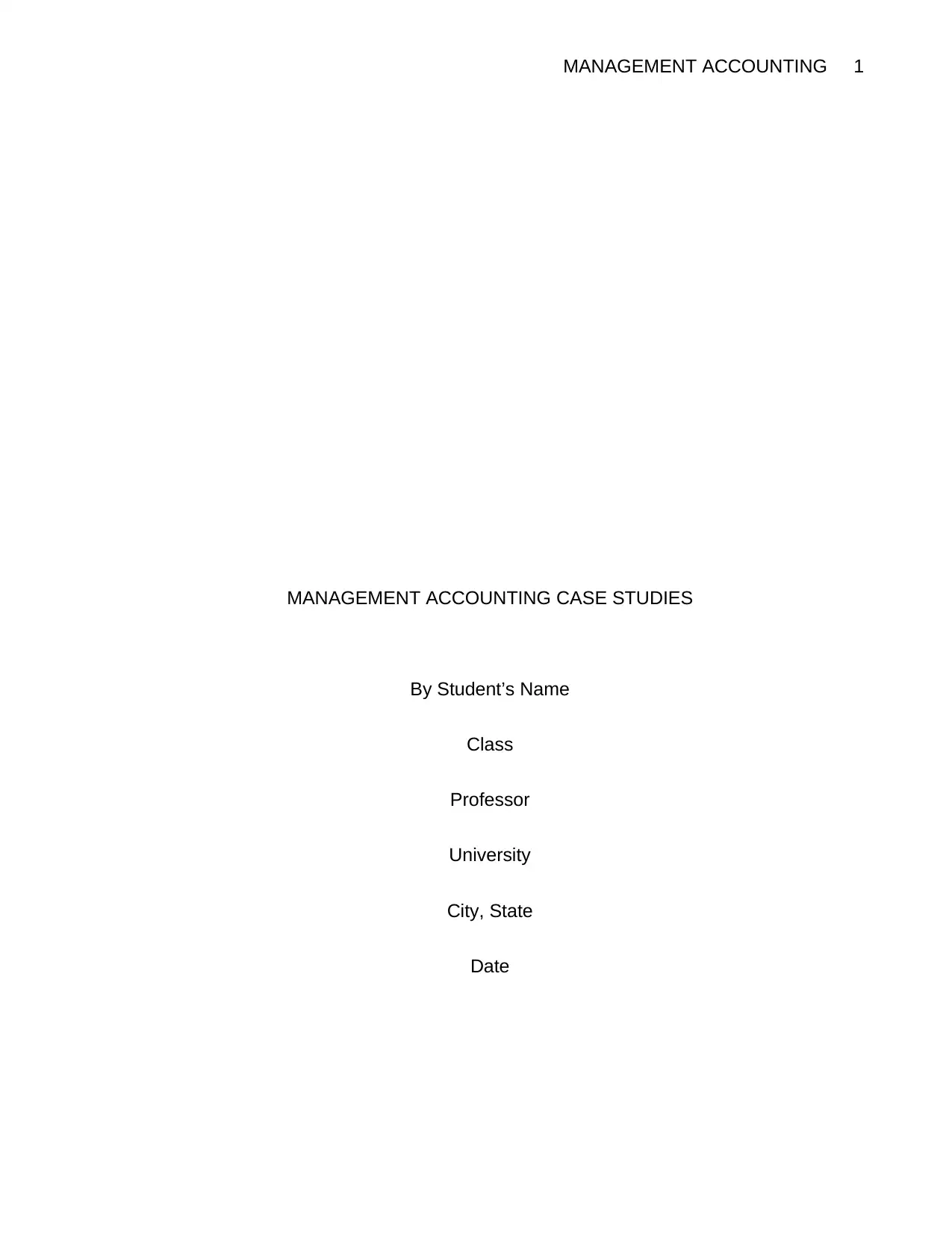
MANAGEMENT ACCOUNTING 1
MANAGEMENT ACCOUNTING CASE STUDIES
By Student’s Name
Class
Professor
University
City, State
Date
MANAGEMENT ACCOUNTING CASE STUDIES
By Student’s Name
Class
Professor
University
City, State
Date
Paraphrase This Document
Need a fresh take? Get an instant paraphrase of this document with our AI Paraphraser
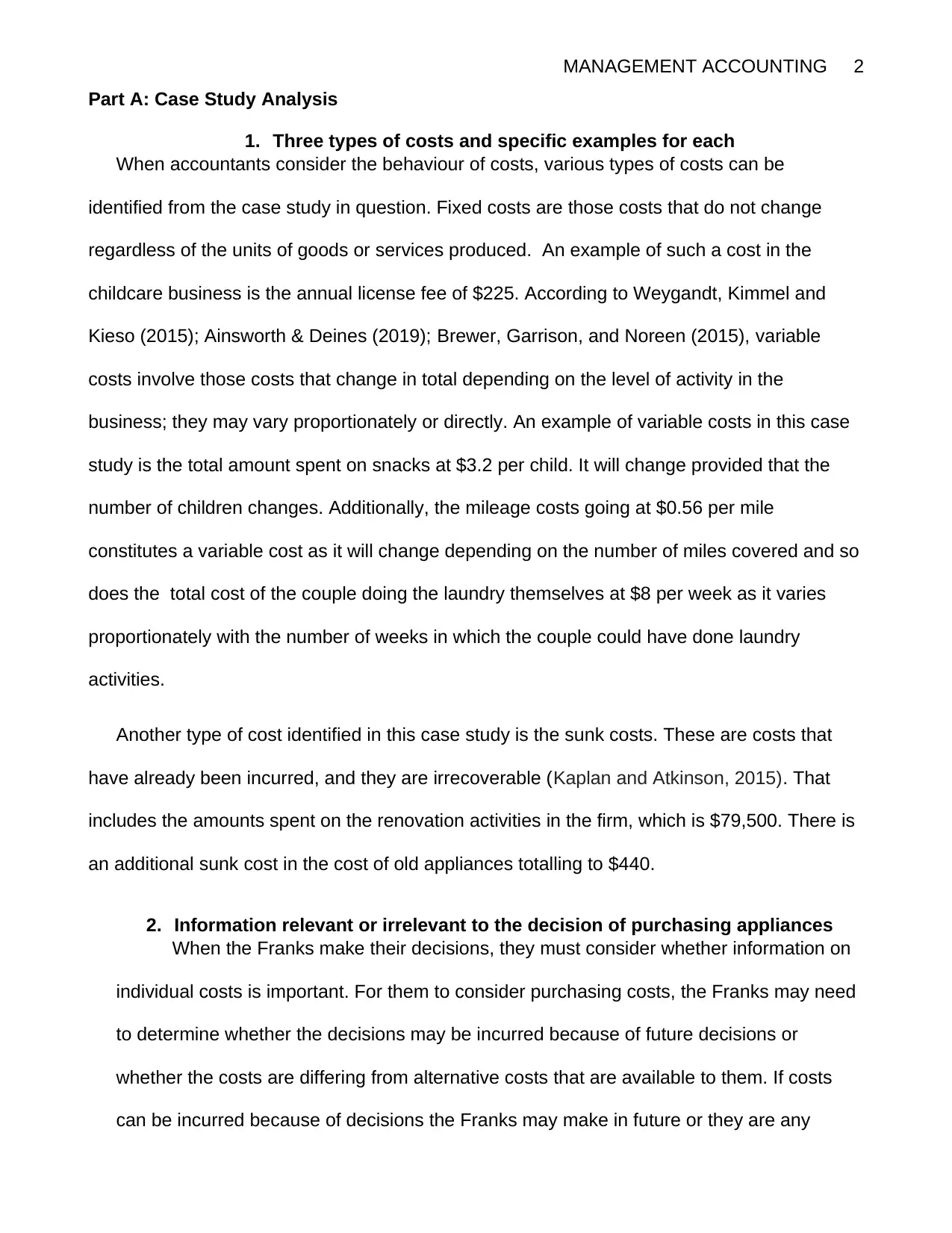
MANAGEMENT ACCOUNTING 2
Part A: Case Study Analysis
1. Three types of costs and specific examples for each
When accountants consider the behaviour of costs, various types of costs can be
identified from the case study in question. Fixed costs are those costs that do not change
regardless of the units of goods or services produced. An example of such a cost in the
childcare business is the annual license fee of $225. According to Weygandt, Kimmel and
Kieso (2015); Ainsworth & Deines (2019); Brewer, Garrison, and Noreen (2015), variable
costs involve those costs that change in total depending on the level of activity in the
business; they may vary proportionately or directly. An example of variable costs in this case
study is the total amount spent on snacks at $3.2 per child. It will change provided that the
number of children changes. Additionally, the mileage costs going at $0.56 per mile
constitutes a variable cost as it will change depending on the number of miles covered and so
does the total cost of the couple doing the laundry themselves at $8 per week as it varies
proportionately with the number of weeks in which the couple could have done laundry
activities.
Another type of cost identified in this case study is the sunk costs. These are costs that
have already been incurred, and they are irrecoverable (Kaplan and Atkinson, 2015). That
includes the amounts spent on the renovation activities in the firm, which is $79,500. There is
an additional sunk cost in the cost of old appliances totalling to $440.
2. Information relevant or irrelevant to the decision of purchasing appliances
When the Franks make their decisions, they must consider whether information on
individual costs is important. For them to consider purchasing costs, the Franks may need
to determine whether the decisions may be incurred because of future decisions or
whether the costs are differing from alternative costs that are available to them. If costs
can be incurred because of decisions the Franks may make in future or they are any
Part A: Case Study Analysis
1. Three types of costs and specific examples for each
When accountants consider the behaviour of costs, various types of costs can be
identified from the case study in question. Fixed costs are those costs that do not change
regardless of the units of goods or services produced. An example of such a cost in the
childcare business is the annual license fee of $225. According to Weygandt, Kimmel and
Kieso (2015); Ainsworth & Deines (2019); Brewer, Garrison, and Noreen (2015), variable
costs involve those costs that change in total depending on the level of activity in the
business; they may vary proportionately or directly. An example of variable costs in this case
study is the total amount spent on snacks at $3.2 per child. It will change provided that the
number of children changes. Additionally, the mileage costs going at $0.56 per mile
constitutes a variable cost as it will change depending on the number of miles covered and so
does the total cost of the couple doing the laundry themselves at $8 per week as it varies
proportionately with the number of weeks in which the couple could have done laundry
activities.
Another type of cost identified in this case study is the sunk costs. These are costs that
have already been incurred, and they are irrecoverable (Kaplan and Atkinson, 2015). That
includes the amounts spent on the renovation activities in the firm, which is $79,500. There is
an additional sunk cost in the cost of old appliances totalling to $440.
2. Information relevant or irrelevant to the decision of purchasing appliances
When the Franks make their decisions, they must consider whether information on
individual costs is important. For them to consider purchasing costs, the Franks may need
to determine whether the decisions may be incurred because of future decisions or
whether the costs are differing from alternative costs that are available to them. If costs
can be incurred because of decisions the Franks may make in future or they are any
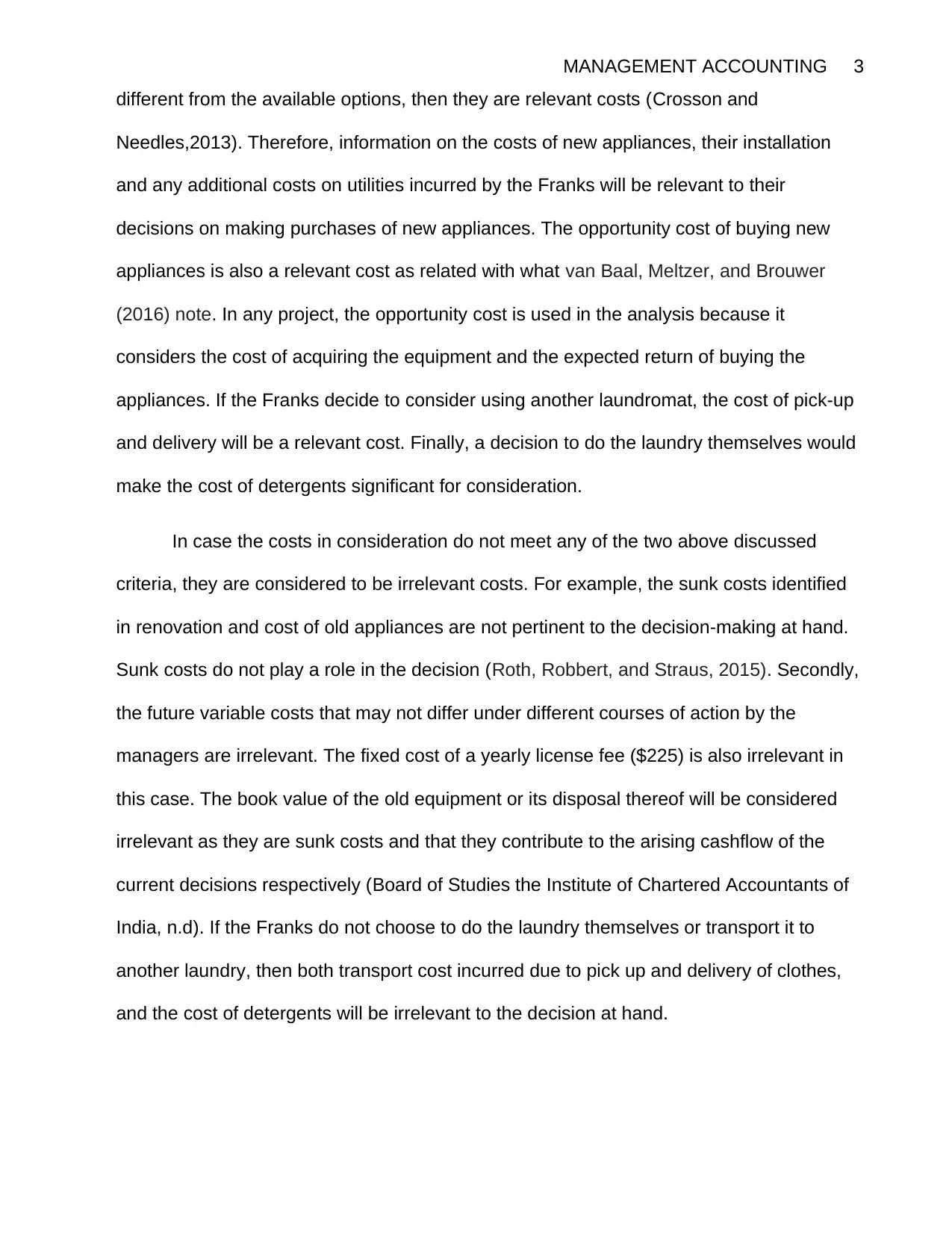
MANAGEMENT ACCOUNTING 3
different from the available options, then they are relevant costs (Crosson and
Needles,2013). Therefore, information on the costs of new appliances, their installation
and any additional costs on utilities incurred by the Franks will be relevant to their
decisions on making purchases of new appliances. The opportunity cost of buying new
appliances is also a relevant cost as related with what van Baal, Meltzer, and Brouwer
(2016) note. In any project, the opportunity cost is used in the analysis because it
considers the cost of acquiring the equipment and the expected return of buying the
appliances. If the Franks decide to consider using another laundromat, the cost of pick-up
and delivery will be a relevant cost. Finally, a decision to do the laundry themselves would
make the cost of detergents significant for consideration.
In case the costs in consideration do not meet any of the two above discussed
criteria, they are considered to be irrelevant costs. For example, the sunk costs identified
in renovation and cost of old appliances are not pertinent to the decision-making at hand.
Sunk costs do not play a role in the decision (Roth, Robbert, and Straus, 2015). Secondly,
the future variable costs that may not differ under different courses of action by the
managers are irrelevant. The fixed cost of a yearly license fee ($225) is also irrelevant in
this case. The book value of the old equipment or its disposal thereof will be considered
irrelevant as they are sunk costs and that they contribute to the arising cashflow of the
current decisions respectively (Board of Studies the Institute of Chartered Accountants of
India, n.d). If the Franks do not choose to do the laundry themselves or transport it to
another laundry, then both transport cost incurred due to pick up and delivery of clothes,
and the cost of detergents will be irrelevant to the decision at hand.
different from the available options, then they are relevant costs (Crosson and
Needles,2013). Therefore, information on the costs of new appliances, their installation
and any additional costs on utilities incurred by the Franks will be relevant to their
decisions on making purchases of new appliances. The opportunity cost of buying new
appliances is also a relevant cost as related with what van Baal, Meltzer, and Brouwer
(2016) note. In any project, the opportunity cost is used in the analysis because it
considers the cost of acquiring the equipment and the expected return of buying the
appliances. If the Franks decide to consider using another laundromat, the cost of pick-up
and delivery will be a relevant cost. Finally, a decision to do the laundry themselves would
make the cost of detergents significant for consideration.
In case the costs in consideration do not meet any of the two above discussed
criteria, they are considered to be irrelevant costs. For example, the sunk costs identified
in renovation and cost of old appliances are not pertinent to the decision-making at hand.
Sunk costs do not play a role in the decision (Roth, Robbert, and Straus, 2015). Secondly,
the future variable costs that may not differ under different courses of action by the
managers are irrelevant. The fixed cost of a yearly license fee ($225) is also irrelevant in
this case. The book value of the old equipment or its disposal thereof will be considered
irrelevant as they are sunk costs and that they contribute to the arising cashflow of the
current decisions respectively (Board of Studies the Institute of Chartered Accountants of
India, n.d). If the Franks do not choose to do the laundry themselves or transport it to
another laundry, then both transport cost incurred due to pick up and delivery of clothes,
and the cost of detergents will be irrelevant to the decision at hand.
⊘ This is a preview!⊘
Do you want full access?
Subscribe today to unlock all pages.

Trusted by 1+ million students worldwide
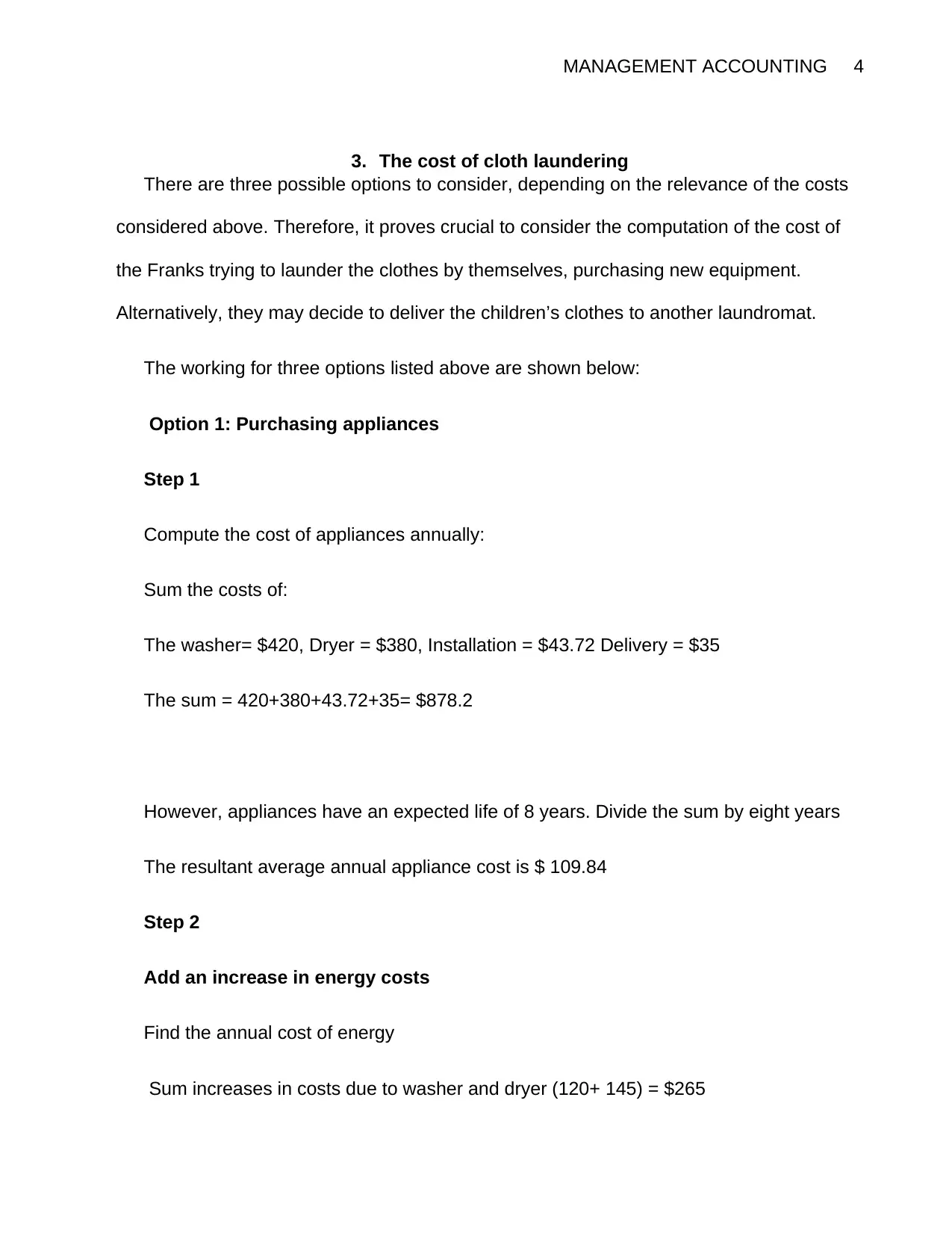
MANAGEMENT ACCOUNTING 4
3. The cost of cloth laundering
There are three possible options to consider, depending on the relevance of the costs
considered above. Therefore, it proves crucial to consider the computation of the cost of
the Franks trying to launder the clothes by themselves, purchasing new equipment.
Alternatively, they may decide to deliver the children’s clothes to another laundromat.
The working for three options listed above are shown below:
Option 1: Purchasing appliances
Step 1
Compute the cost of appliances annually:
Sum the costs of:
The washer= $420, Dryer = $380, Installation = $43.72 Delivery = $35
The sum = 420+380+43.72+35= $878.2
However, appliances have an expected life of 8 years. Divide the sum by eight years
The resultant average annual appliance cost is $ 109.84
Step 2
Add an increase in energy costs
Find the annual cost of energy
Sum increases in costs due to washer and dryer (120+ 145) = $265
3. The cost of cloth laundering
There are three possible options to consider, depending on the relevance of the costs
considered above. Therefore, it proves crucial to consider the computation of the cost of
the Franks trying to launder the clothes by themselves, purchasing new equipment.
Alternatively, they may decide to deliver the children’s clothes to another laundromat.
The working for three options listed above are shown below:
Option 1: Purchasing appliances
Step 1
Compute the cost of appliances annually:
Sum the costs of:
The washer= $420, Dryer = $380, Installation = $43.72 Delivery = $35
The sum = 420+380+43.72+35= $878.2
However, appliances have an expected life of 8 years. Divide the sum by eight years
The resultant average annual appliance cost is $ 109.84
Step 2
Add an increase in energy costs
Find the annual cost of energy
Sum increases in costs due to washer and dryer (120+ 145) = $265
Paraphrase This Document
Need a fresh take? Get an instant paraphrase of this document with our AI Paraphraser
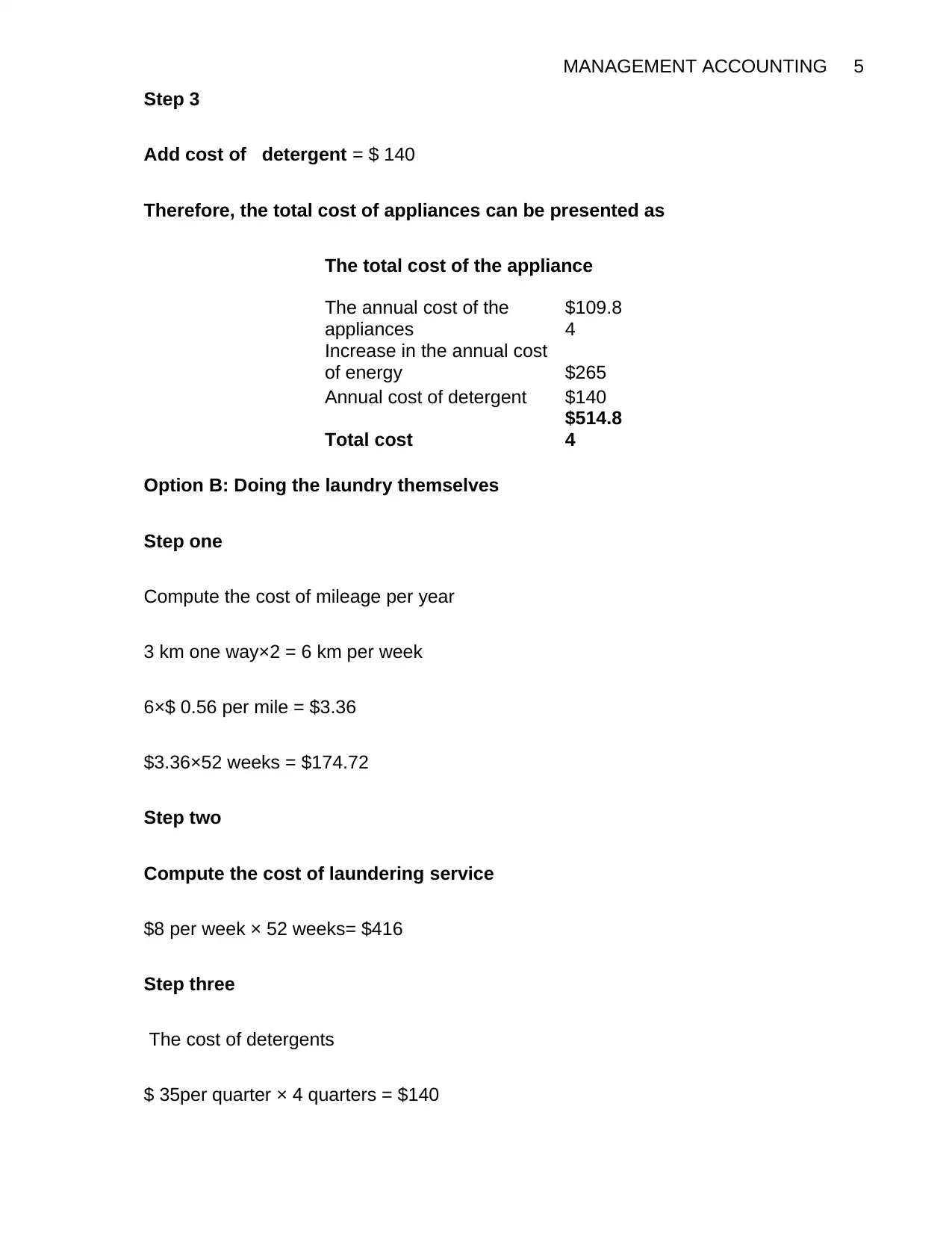
MANAGEMENT ACCOUNTING 5
Step 3
Add cost of detergent = $ 140
Therefore, the total cost of appliances can be presented as
The total cost of the appliance
The annual cost of the
appliances
$109.8
4
Increase in the annual cost
of energy $265
Annual cost of detergent $140
Total cost
$514.8
4
Option B: Doing the laundry themselves
Step one
Compute the cost of mileage per year
3 km one way×2 = 6 km per week
6×$ 0.56 per mile = $3.36
$3.36×52 weeks = $174.72
Step two
Compute the cost of laundering service
$8 per week × 52 weeks= $416
Step three
The cost of detergents
$ 35per quarter × 4 quarters = $140
Step 3
Add cost of detergent = $ 140
Therefore, the total cost of appliances can be presented as
The total cost of the appliance
The annual cost of the
appliances
$109.8
4
Increase in the annual cost
of energy $265
Annual cost of detergent $140
Total cost
$514.8
4
Option B: Doing the laundry themselves
Step one
Compute the cost of mileage per year
3 km one way×2 = 6 km per week
6×$ 0.56 per mile = $3.36
$3.36×52 weeks = $174.72
Step two
Compute the cost of laundering service
$8 per week × 52 weeks= $416
Step three
The cost of detergents
$ 35per quarter × 4 quarters = $140
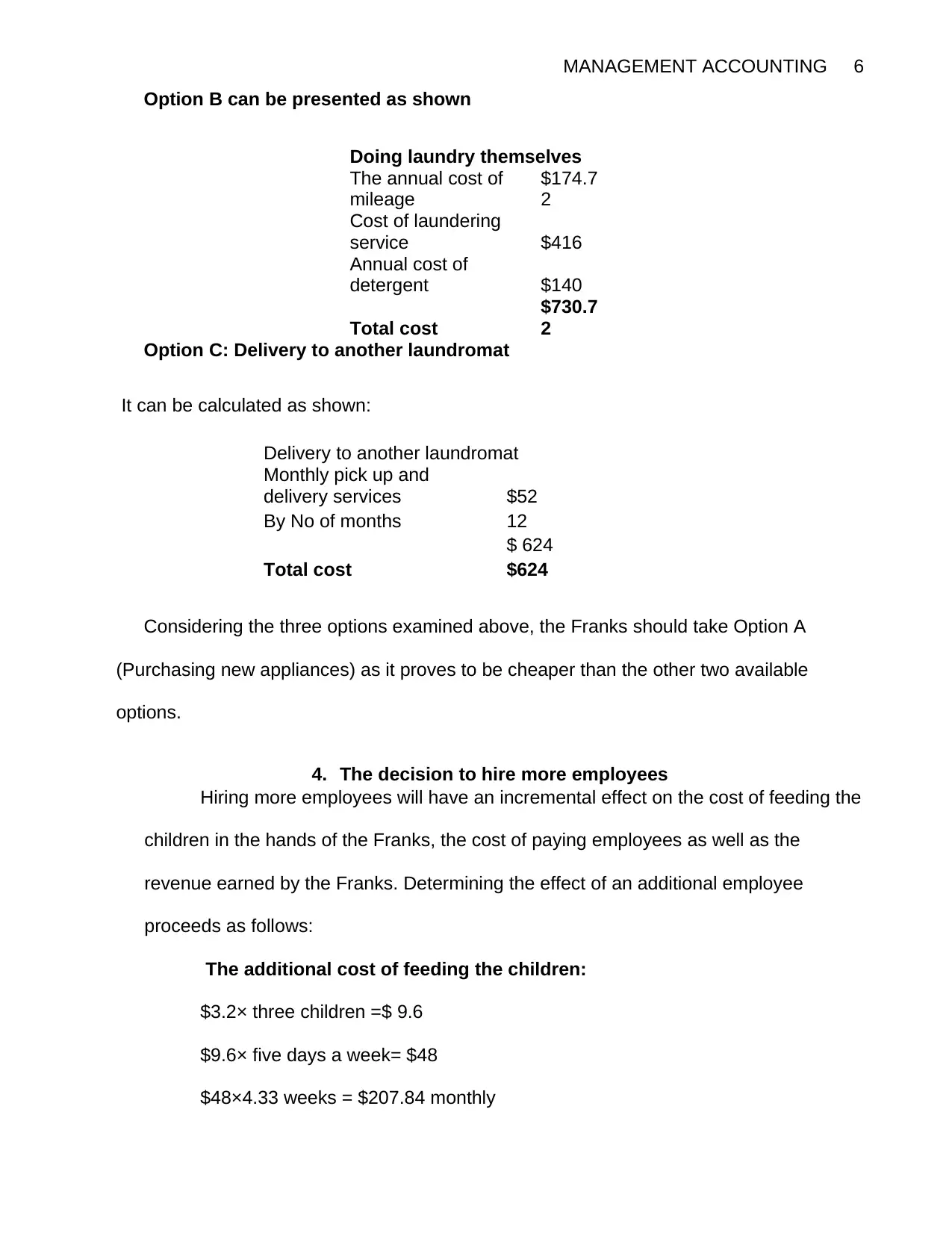
MANAGEMENT ACCOUNTING 6
Option B can be presented as shown
Doing laundry themselves
The annual cost of
mileage
$174.7
2
Cost of laundering
service $416
Annual cost of
detergent $140
Total cost
$730.7
2
Option C: Delivery to another laundromat
It can be calculated as shown:
Considering the three options examined above, the Franks should take Option A
(Purchasing new appliances) as it proves to be cheaper than the other two available
options.
4. The decision to hire more employees
Hiring more employees will have an incremental effect on the cost of feeding the
children in the hands of the Franks, the cost of paying employees as well as the
revenue earned by the Franks. Determining the effect of an additional employee
proceeds as follows:
The additional cost of feeding the children:
$3.2× three children =$ 9.6
$9.6× five days a week= $48
$48×4.33 weeks = $207.84 monthly
Delivery to another laundromat
Monthly pick up and
delivery services $52
By No of months 12
$ 624
Total cost $624
Option B can be presented as shown
Doing laundry themselves
The annual cost of
mileage
$174.7
2
Cost of laundering
service $416
Annual cost of
detergent $140
Total cost
$730.7
2
Option C: Delivery to another laundromat
It can be calculated as shown:
Considering the three options examined above, the Franks should take Option A
(Purchasing new appliances) as it proves to be cheaper than the other two available
options.
4. The decision to hire more employees
Hiring more employees will have an incremental effect on the cost of feeding the
children in the hands of the Franks, the cost of paying employees as well as the
revenue earned by the Franks. Determining the effect of an additional employee
proceeds as follows:
The additional cost of feeding the children:
$3.2× three children =$ 9.6
$9.6× five days a week= $48
$48×4.33 weeks = $207.84 monthly
Delivery to another laundromat
Monthly pick up and
delivery services $52
By No of months 12
$ 624
Total cost $624
⊘ This is a preview!⊘
Do you want full access?
Subscribe today to unlock all pages.

Trusted by 1+ million students worldwide
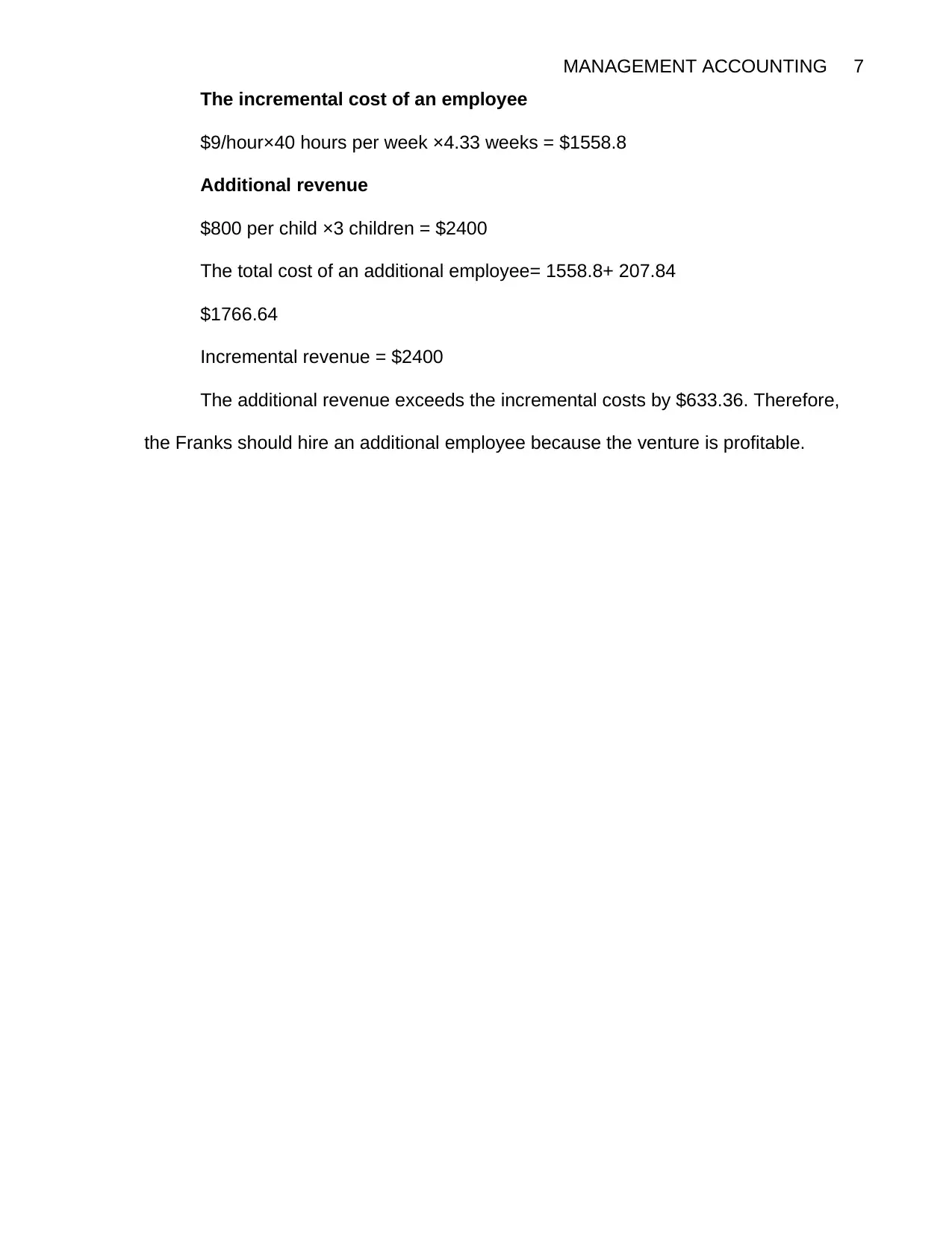
MANAGEMENT ACCOUNTING 7
The incremental cost of an employee
$9/hour×40 hours per week ×4.33 weeks = $1558.8
Additional revenue
$800 per child ×3 children = $2400
The total cost of an additional employee= 1558.8+ 207.84
$1766.64
Incremental revenue = $2400
The additional revenue exceeds the incremental costs by $633.36. Therefore,
the Franks should hire an additional employee because the venture is profitable.
The incremental cost of an employee
$9/hour×40 hours per week ×4.33 weeks = $1558.8
Additional revenue
$800 per child ×3 children = $2400
The total cost of an additional employee= 1558.8+ 207.84
$1766.64
Incremental revenue = $2400
The additional revenue exceeds the incremental costs by $633.36. Therefore,
the Franks should hire an additional employee because the venture is profitable.
Paraphrase This Document
Need a fresh take? Get an instant paraphrase of this document with our AI Paraphraser
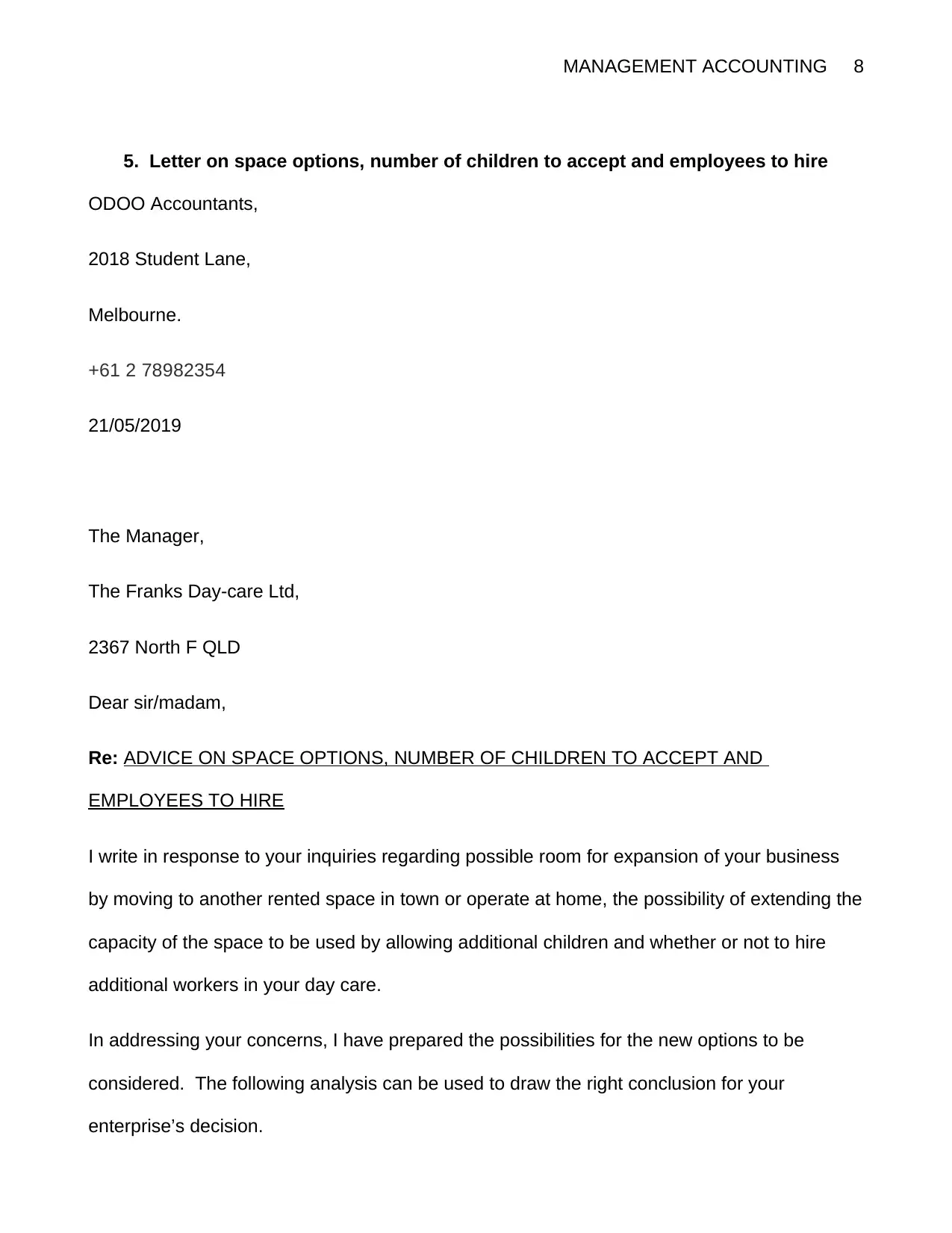
MANAGEMENT ACCOUNTING 8
5. Letter on space options, number of children to accept and employees to hire
ODOO Accountants,
2018 Student Lane,
Melbourne.
+61 2 78982354
21/05/2019
The Manager,
The Franks Day-care Ltd,
2367 North F QLD
Dear sir/madam,
Re: ADVICE ON SPACE OPTIONS, NUMBER OF CHILDREN TO ACCEPT AND
EMPLOYEES TO HIRE
I write in response to your inquiries regarding possible room for expansion of your business
by moving to another rented space in town or operate at home, the possibility of extending the
capacity of the space to be used by allowing additional children and whether or not to hire
additional workers in your day care.
In addressing your concerns, I have prepared the possibilities for the new options to be
considered. The following analysis can be used to draw the right conclusion for your
enterprise’s decision.
5. Letter on space options, number of children to accept and employees to hire
ODOO Accountants,
2018 Student Lane,
Melbourne.
+61 2 78982354
21/05/2019
The Manager,
The Franks Day-care Ltd,
2367 North F QLD
Dear sir/madam,
Re: ADVICE ON SPACE OPTIONS, NUMBER OF CHILDREN TO ACCEPT AND
EMPLOYEES TO HIRE
I write in response to your inquiries regarding possible room for expansion of your business
by moving to another rented space in town or operate at home, the possibility of extending the
capacity of the space to be used by allowing additional children and whether or not to hire
additional workers in your day care.
In addressing your concerns, I have prepared the possibilities for the new options to be
considered. The following analysis can be used to draw the right conclusion for your
enterprise’s decision.
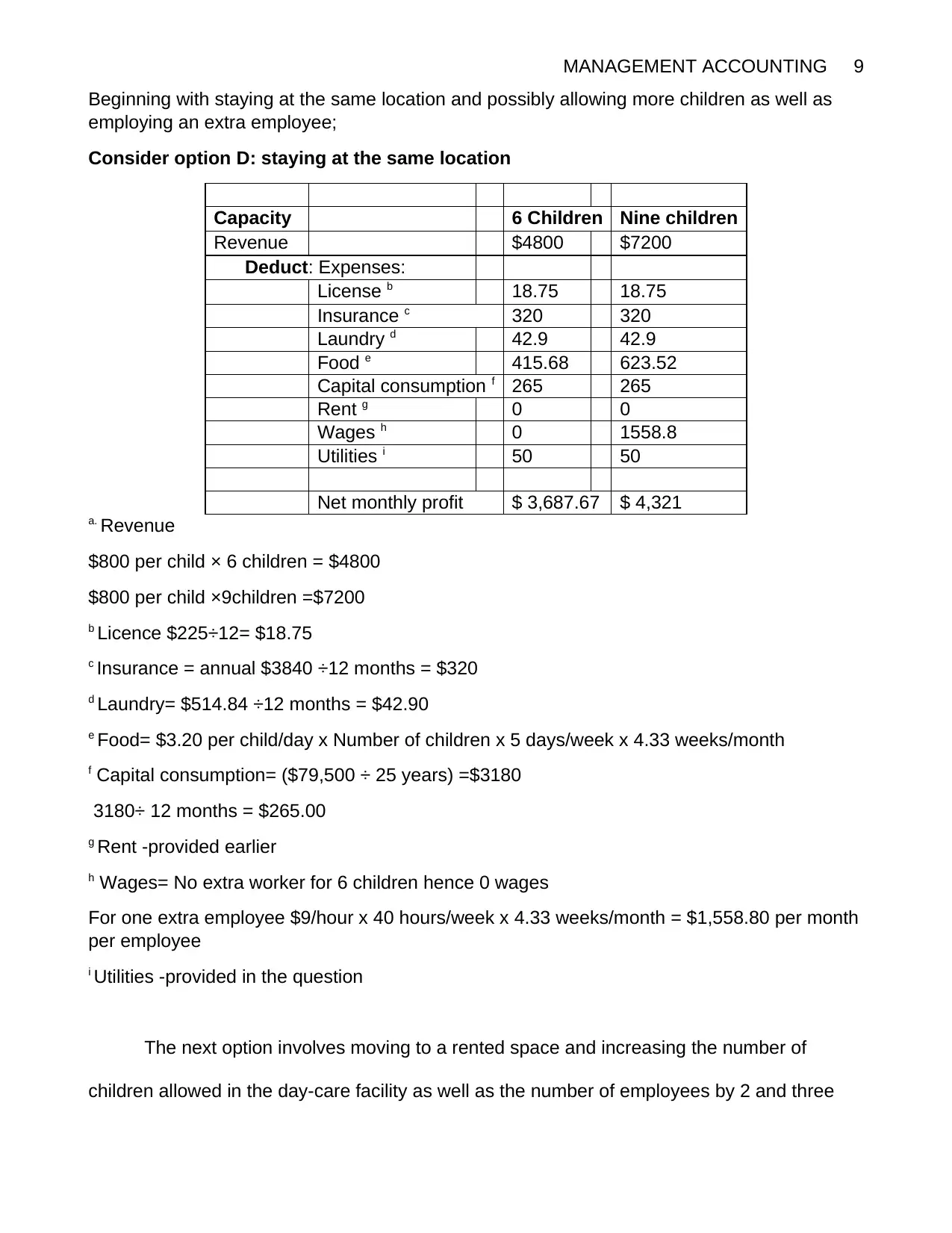
MANAGEMENT ACCOUNTING 9
Beginning with staying at the same location and possibly allowing more children as well as
employing an extra employee;
Consider option D: staying at the same location
Capacity 6 Children Nine children
Revenue $4800 $7200
Deduct: Expenses:
License b 18.75 18.75
Insurance c 320 320
Laundry d 42.9 42.9
Food e 415.68 623.52
Capital consumption f 265 265
Rent g 0 0
Wages h 0 1558.8
Utilities i 50 50
Net monthly profit $ 3,687.67 $ 4,321
a. Revenue
$800 per child × 6 children = $4800
$800 per child ×9children =$7200
b Licence $225÷12= $18.75
c Insurance = annual $3840 ÷12 months = $320
d Laundry= $514.84 ÷12 months = $42.90
e Food= $3.20 per child/day x Number of children x 5 days/week x 4.33 weeks/month
f Capital consumption= ($79,500 ÷ 25 years) =$3180
3180÷ 12 months = $265.00
g Rent -provided earlier
h Wages= No extra worker for 6 children hence 0 wages
For one extra employee $9/hour x 40 hours/week x 4.33 weeks/month = $1,558.80 per month
per employee
i Utilities -provided in the question
The next option involves moving to a rented space and increasing the number of
children allowed in the day-care facility as well as the number of employees by 2 and three
Beginning with staying at the same location and possibly allowing more children as well as
employing an extra employee;
Consider option D: staying at the same location
Capacity 6 Children Nine children
Revenue $4800 $7200
Deduct: Expenses:
License b 18.75 18.75
Insurance c 320 320
Laundry d 42.9 42.9
Food e 415.68 623.52
Capital consumption f 265 265
Rent g 0 0
Wages h 0 1558.8
Utilities i 50 50
Net monthly profit $ 3,687.67 $ 4,321
a. Revenue
$800 per child × 6 children = $4800
$800 per child ×9children =$7200
b Licence $225÷12= $18.75
c Insurance = annual $3840 ÷12 months = $320
d Laundry= $514.84 ÷12 months = $42.90
e Food= $3.20 per child/day x Number of children x 5 days/week x 4.33 weeks/month
f Capital consumption= ($79,500 ÷ 25 years) =$3180
3180÷ 12 months = $265.00
g Rent -provided earlier
h Wages= No extra worker for 6 children hence 0 wages
For one extra employee $9/hour x 40 hours/week x 4.33 weeks/month = $1,558.80 per month
per employee
i Utilities -provided in the question
The next option involves moving to a rented space and increasing the number of
children allowed in the day-care facility as well as the number of employees by 2 and three
⊘ This is a preview!⊘
Do you want full access?
Subscribe today to unlock all pages.

Trusted by 1+ million students worldwide
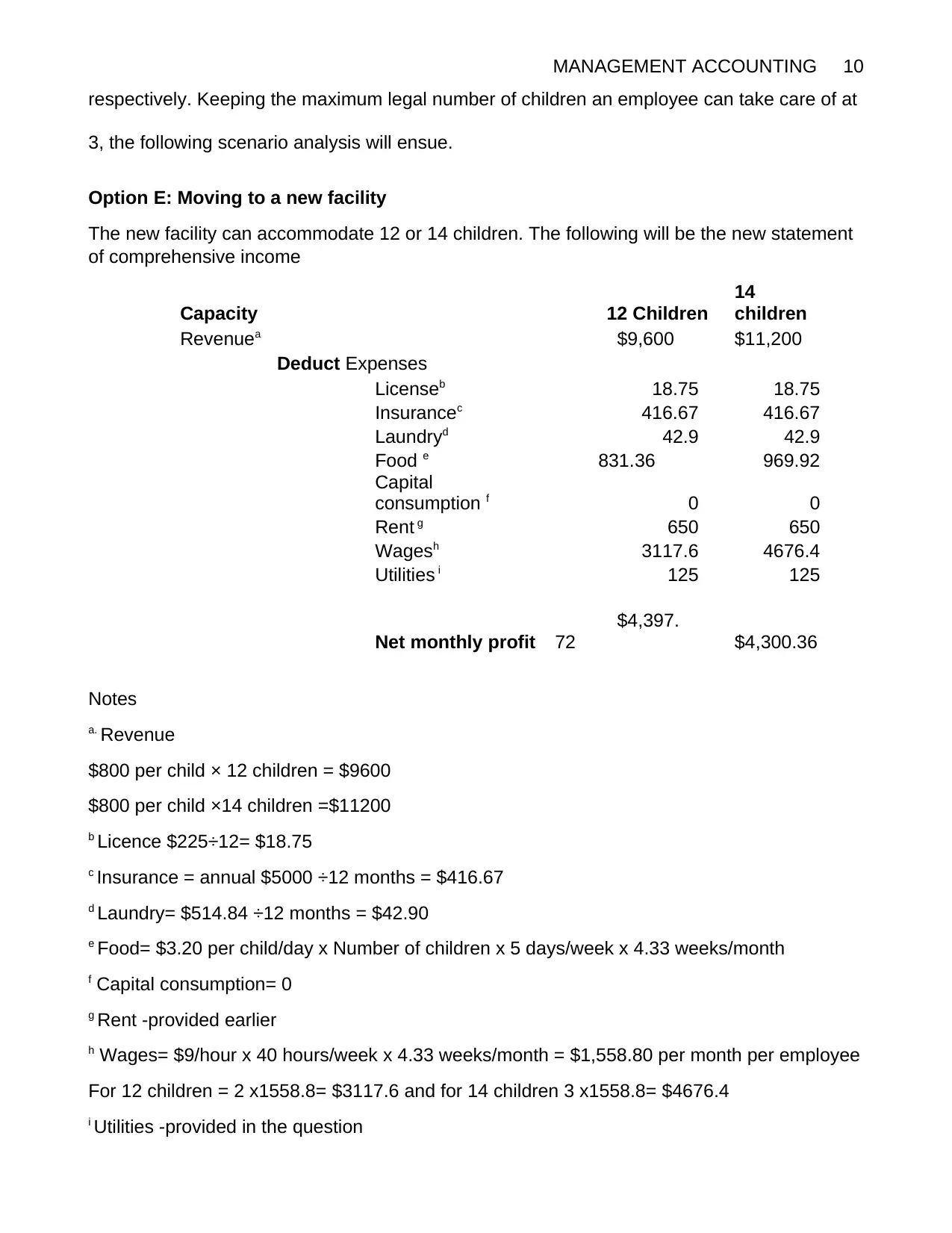
MANAGEMENT ACCOUNTING 10
respectively. Keeping the maximum legal number of children an employee can take care of at
3, the following scenario analysis will ensue.
Option E: Moving to a new facility
The new facility can accommodate 12 or 14 children. The following will be the new statement
of comprehensive income
Capacity 12 Children
14
children
Revenuea $9,600 $11,200
Deduct Expenses
Licenseb 18.75 18.75
Insurancec 416.67 416.67
Laundryd 42.9 42.9
Food e 831.36 969.92
Capital
consumption f 0 0
Rent g 650 650
Wagesh 3117.6 4676.4
Utilities i 125 125
Net monthly profit
$4,397.
72 $4,300.36
Notes
a. Revenue
$800 per child × 12 children = $9600
$800 per child ×14 children =$11200
b Licence $225÷12= $18.75
c Insurance = annual $5000 ÷12 months = $416.67
d Laundry= $514.84 ÷12 months = $42.90
e Food= $3.20 per child/day x Number of children x 5 days/week x 4.33 weeks/month
f Capital consumption= 0
g Rent -provided earlier
h Wages= $9/hour x 40 hours/week x 4.33 weeks/month = $1,558.80 per month per employee
For 12 children = 2 x1558.8= $3117.6 and for 14 children 3 x1558.8= $4676.4
i Utilities -provided in the question
respectively. Keeping the maximum legal number of children an employee can take care of at
3, the following scenario analysis will ensue.
Option E: Moving to a new facility
The new facility can accommodate 12 or 14 children. The following will be the new statement
of comprehensive income
Capacity 12 Children
14
children
Revenuea $9,600 $11,200
Deduct Expenses
Licenseb 18.75 18.75
Insurancec 416.67 416.67
Laundryd 42.9 42.9
Food e 831.36 969.92
Capital
consumption f 0 0
Rent g 650 650
Wagesh 3117.6 4676.4
Utilities i 125 125
Net monthly profit
$4,397.
72 $4,300.36
Notes
a. Revenue
$800 per child × 12 children = $9600
$800 per child ×14 children =$11200
b Licence $225÷12= $18.75
c Insurance = annual $5000 ÷12 months = $416.67
d Laundry= $514.84 ÷12 months = $42.90
e Food= $3.20 per child/day x Number of children x 5 days/week x 4.33 weeks/month
f Capital consumption= 0
g Rent -provided earlier
h Wages= $9/hour x 40 hours/week x 4.33 weeks/month = $1,558.80 per month per employee
For 12 children = 2 x1558.8= $3117.6 and for 14 children 3 x1558.8= $4676.4
i Utilities -provided in the question
Paraphrase This Document
Need a fresh take? Get an instant paraphrase of this document with our AI Paraphraser
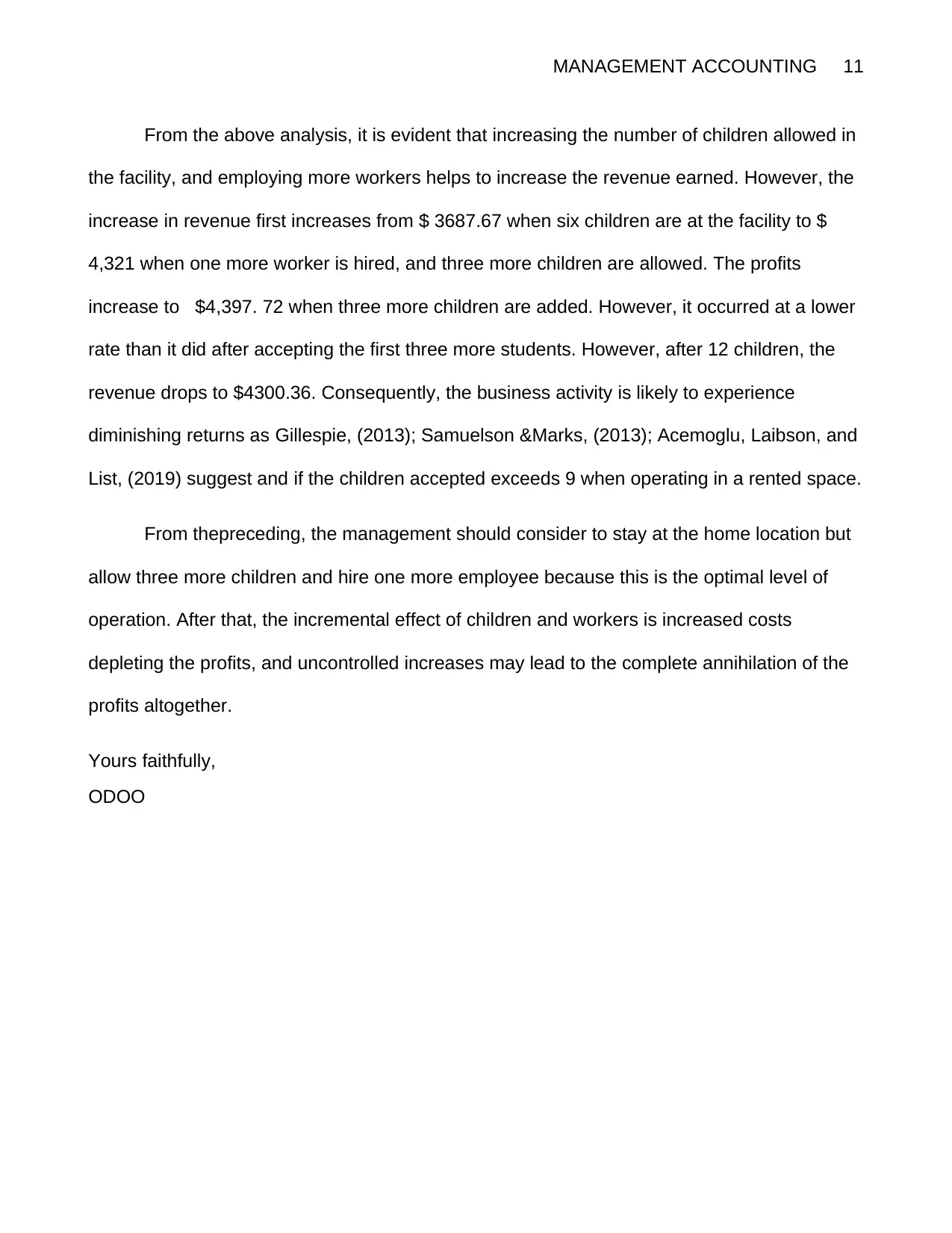
MANAGEMENT ACCOUNTING 11
From the above analysis, it is evident that increasing the number of children allowed in
the facility, and employing more workers helps to increase the revenue earned. However, the
increase in revenue first increases from $ 3687.67 when six children are at the facility to $
4,321 when one more worker is hired, and three more children are allowed. The profits
increase to $4,397. 72 when three more children are added. However, it occurred at a lower
rate than it did after accepting the first three more students. However, after 12 children, the
revenue drops to $4300.36. Consequently, the business activity is likely to experience
diminishing returns as Gillespie, (2013); Samuelson &Marks, (2013); Acemoglu, Laibson, and
List, (2019) suggest and if the children accepted exceeds 9 when operating in a rented space.
From thepreceding, the management should consider to stay at the home location but
allow three more children and hire one more employee because this is the optimal level of
operation. After that, the incremental effect of children and workers is increased costs
depleting the profits, and uncontrolled increases may lead to the complete annihilation of the
profits altogether.
Yours faithfully,
ODOO
From the above analysis, it is evident that increasing the number of children allowed in
the facility, and employing more workers helps to increase the revenue earned. However, the
increase in revenue first increases from $ 3687.67 when six children are at the facility to $
4,321 when one more worker is hired, and three more children are allowed. The profits
increase to $4,397. 72 when three more children are added. However, it occurred at a lower
rate than it did after accepting the first three more students. However, after 12 children, the
revenue drops to $4300.36. Consequently, the business activity is likely to experience
diminishing returns as Gillespie, (2013); Samuelson &Marks, (2013); Acemoglu, Laibson, and
List, (2019) suggest and if the children accepted exceeds 9 when operating in a rented space.
From thepreceding, the management should consider to stay at the home location but
allow three more children and hire one more employee because this is the optimal level of
operation. After that, the incremental effect of children and workers is increased costs
depleting the profits, and uncontrolled increases may lead to the complete annihilation of the
profits altogether.
Yours faithfully,
ODOO
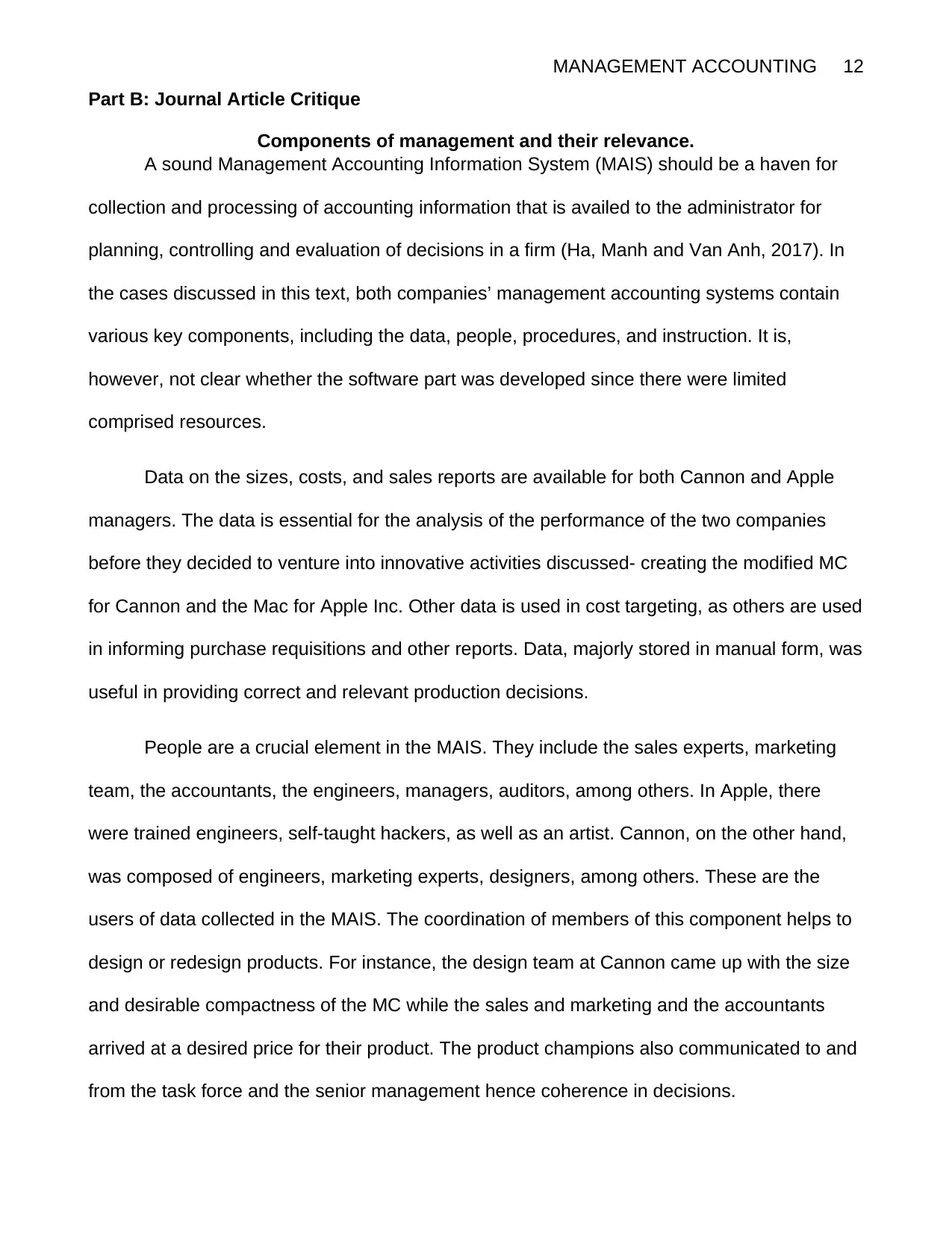
MANAGEMENT ACCOUNTING 12
Part B: Journal Article Critique
Components of management and their relevance.
A sound Management Accounting Information System (MAIS) should be a haven for
collection and processing of accounting information that is availed to the administrator for
planning, controlling and evaluation of decisions in a firm (Ha, Manh and Van Anh, 2017). In
the cases discussed in this text, both companies’ management accounting systems contain
various key components, including the data, people, procedures, and instruction. It is,
however, not clear whether the software part was developed since there were limited
comprised resources.
Data on the sizes, costs, and sales reports are available for both Cannon and Apple
managers. The data is essential for the analysis of the performance of the two companies
before they decided to venture into innovative activities discussed- creating the modified MC
for Cannon and the Mac for Apple Inc. Other data is used in cost targeting, as others are used
in informing purchase requisitions and other reports. Data, majorly stored in manual form, was
useful in providing correct and relevant production decisions.
People are a crucial element in the MAIS. They include the sales experts, marketing
team, the accountants, the engineers, managers, auditors, among others. In Apple, there
were trained engineers, self-taught hackers, as well as an artist. Cannon, on the other hand,
was composed of engineers, marketing experts, designers, among others. These are the
users of data collected in the MAIS. The coordination of members of this component helps to
design or redesign products. For instance, the design team at Cannon came up with the size
and desirable compactness of the MC while the sales and marketing and the accountants
arrived at a desired price for their product. The product champions also communicated to and
from the task force and the senior management hence coherence in decisions.
Part B: Journal Article Critique
Components of management and their relevance.
A sound Management Accounting Information System (MAIS) should be a haven for
collection and processing of accounting information that is availed to the administrator for
planning, controlling and evaluation of decisions in a firm (Ha, Manh and Van Anh, 2017). In
the cases discussed in this text, both companies’ management accounting systems contain
various key components, including the data, people, procedures, and instruction. It is,
however, not clear whether the software part was developed since there were limited
comprised resources.
Data on the sizes, costs, and sales reports are available for both Cannon and Apple
managers. The data is essential for the analysis of the performance of the two companies
before they decided to venture into innovative activities discussed- creating the modified MC
for Cannon and the Mac for Apple Inc. Other data is used in cost targeting, as others are used
in informing purchase requisitions and other reports. Data, majorly stored in manual form, was
useful in providing correct and relevant production decisions.
People are a crucial element in the MAIS. They include the sales experts, marketing
team, the accountants, the engineers, managers, auditors, among others. In Apple, there
were trained engineers, self-taught hackers, as well as an artist. Cannon, on the other hand,
was composed of engineers, marketing experts, designers, among others. These are the
users of data collected in the MAIS. The coordination of members of this component helps to
design or redesign products. For instance, the design team at Cannon came up with the size
and desirable compactness of the MC while the sales and marketing and the accountants
arrived at a desired price for their product. The product champions also communicated to and
from the task force and the senior management hence coherence in decisions.
⊘ This is a preview!⊘
Do you want full access?
Subscribe today to unlock all pages.

Trusted by 1+ million students worldwide
1 out of 19
Related Documents
Your All-in-One AI-Powered Toolkit for Academic Success.
+13062052269
info@desklib.com
Available 24*7 on WhatsApp / Email
![[object Object]](/_next/static/media/star-bottom.7253800d.svg)
Unlock your academic potential
Copyright © 2020–2025 A2Z Services. All Rights Reserved. Developed and managed by ZUCOL.





